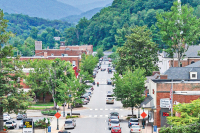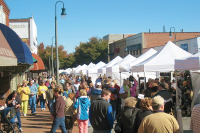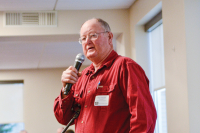A noble cause on the surface, Waynesville’s smoking ban on sidewalks is fraught with what-ifs
Waynesville leaders are wrestling over how far to go with a smoking ban in public spaces.
The proposed ban would apply to sidewalks and streets in business districts throughout town, from Main Street to Russ Avenue.
The ban would have the greatest impact downtown, however. Smokers would have to step off the sidewalk and onto private property to smoke, but there’s relatively few islands of private property downtown where it would be kosher — essentially constituting a blanket ban, according to David Young, who spoke at a public hearing on the smoking ban last week.
“It is a sweeping, overly broad solution to a very small problem,” Young told aldermen. “There has to be some middle ground between the complete lack of regulation we have now, and this overarching ban that has been proposed.”
Young doesn’t smoke, but as a downtown business owner, he is worried about the impact of a smoking ban on commerce.
“It will drive away patrons from bars, restaurants and shops throughout the downtown area,” said Young.
Related Items
But downtown is likewise the area where a smoking ban is needed the most, “by virtue of lots of people gathered in very close quarters,” said Waynesville Town Manager Marcy Onieal.
“It is more a matter of how we can coexist and respect each other and share space together,” Onieal said.
Town leaders are still hashing out what the ban would look like, if it is enacted at all.
The town stumbled on the wording in the first draft of the ban, making it far broader than intended.
The first draft called for a 50-foot no-smoking zone around the main entrance to any business. It was intended only for sidewalks that fell within the 50-foot buffer, but the wording failed to stipulate that private property was exempt.
So by default, it would have reached onto private property, banning smoking anywhere within 50 feet of a business’ front door — even in the private parking lots of gas stations, Laundromats, Walmart, fast-food joints and so on.
“We may have inadvertently had some unintended consequences,” Onieal said. “We know we need to go back and correct some language in here. The intent all along was just the public sidewalks in front of commercial buildings.”
The town plans to strike the reference to a 50-foot buffer zone, and come up a new version that applies only to public spaces like sidewalks.
That is marginally more palatable to Young. He is opening a new beer garden on Branner Avenue with a deck for smokers. But the deck is within 50 feet of the bar’s front door, so the smoking ban as initially written would have cost him patrons — banning smoking on his own bar deck.
Young said 20 percent of adults smoke, but people who go out drinking are a “higher smoking demographic” and bar owners risk a sizeable share of business if there is nowhere they can step outside and smoke.
Only three people came to the public hearing to lodge concerns over the smoking ban last week. The majority of town aldermen appeared to be in favor of some sort of ban, based on their discussion.
The only one to express reservations was Alderman Gary Caldwell.
“We might be opening a can of worms. When you start saying you can’t smoke outside a bar or a restaurant, I just don’t know,” Caldwell said. “I am not a smoker but a person has his own rights.”
“Do they have the right to force others to have unintended exposure to second-hand smoke?” Onieal asked.
Mayor Gavin Brown countered that the debate was limited to the public sphere. Nothing would stop you from smoking outside a bar or restaurant — as long as you weren’t stepping on to the public sidewalk to do so.
“We are dealing with the concept of a public space,” Brown said.
But downtown, few businesses have the luxury of their own parking lot for smokers. Once you step out the door, you land immediately and directly on the sidewalk.
“What if people step into the street, can they smoke in the street?” Alderwoman Julia Freeman asked.
“You have raised a good question there,” Onieal said.
State statute gives cities and towns the right to ban smoking in public spaces, but there’s no clear definition of a public space.
“The statute is pretty clear in being vague. The statute says we can regulate smoking in public spaces,” Brown said. “We’ll have to figure out along with everyone else what a public space is.”
No matter how the town slices and dices the language, smokers will search out the loopholes and find safe zones, Freeman postulated.
“People are going to get around whatever you come up with,” Freeman said.
Technically, the town has the latitude to make the ban quite sweeping if it wants to. Onieal shared a laundry list of locally-enacted smoking bans around the country that indeed apply even on private property: common areas in apartment buildings, lobbies of hotels, nursing homes, shopping malls, bus stations and ticket lines.
“It is fairly wide open in terms of what this board and this community chooses to regulate in terms of public health protection,” Onieal said.
The town is considering a more comprehensive smoking ban during parades and festivals. It would apply to any outside space within the parade or festival boundaries, even private property, since the second-hand smoke would waft onto crowds.
What’s next
The town will float a new version of the ordinance in April and hold another public hearing in May. If enacted, it would have a three- to six-month grace period before going into effect.
Cameron Corley, who is opening the new beer garden with Young, suggested the town create a designated smoking area. Corley said there are many people who live in second-floor apartments over Main Street who wouldn’t be able to step outside their own apartment to smoke since it would put them on the sidewalk.
Another compromise: limit no-smoking-on-the-sidewalk hours to the daytime. Come evening, when Main Street transitions from tourist families to bar-goers, the smoking ban would be lifted.
With eight bars within easy walking distance downtown, a blanket smoking ban could put a damper on people hopping from one to the next.
“If we are going to do the smoking ban, I think it is in the town’s best interest to have a time frame,” said Amanda Graham, who is also involved in the beer garden venture.
Young proposed yet another compromise that would allow businesses to opt-in if they want smoking banned on their stretch of sidewalk. Window decals could show which businesses had opted in, he said.
A logistical issue is obviously who will police the ban.
“An ordinance like this is only as good as the enforcement. That is the big concern I have,” said Alderman Leroy Roberson. For the record, Roberson likes the idea of a smoking ban on Main Street. As a retired optometrist, he saw the side effects of smoking on vision loss, including increased risk of macular degeneration.
Technically, people violating the ban could get a $50 ticket. But in reality, Onieal doesn’t see that happening. “We are not going to be following people around with a ticket book in hand,” Onieal said. “We would rather not have to enforce this ordinance at all. Our desire is to raise awareness.”
Enforcement would more likely be complaint-based and reserved for intentional repeat offenders.
Even then, the job won’t fall to police officers. All town employees — whether its garbage men going down Main Street or landscape crews at the town rec park — will be empowered to ticket offenders.
Young said the ban could be a turn off for tourists who smoke along Main Street. Getting hassled by town employees won’t leave a good impression on them.
“If I had to guess, I’d assume that they’ll go inside the shops, tell the rest of their party what happened, and leave Waynesville forever. That kind of negative experience, including public humiliation and a fine, won’t be quickly forgotten,” he said.
Worse, it will make the rounds on social media, Young said. Downtown Waynesville’s tourist economy stands to lose more than it gains.
“Nobody will come to Waynesville for its non-smoking streets, sidewalks and green spaces,” Young said. “It just seems that this proposed ordinance has little potential to help the downtown area, and great potential to do harm.”
Second-hand health vs. smoker shame
The town smoking ban in public places would also apply to parks and recreation grounds.
Smoking is commonplace at the town skateboard park — and not just on the sidelines. Some teens even smoke on their skateboards, rolling up and down the ramps with a cigarette hanging from their lips. Smoking is also common around the perimeter of softball games at town ball fields.
But smoking bans in public parks have become the norm. Many counties and towns in the region already ban smoking at city and county parks — Waynesville would actually be a latecomer on that front.
Smoking bans are usually billed as protecting the public from the dangerous scourge of second-hand smoke.
“People should not be involuntarily exposed to second-hand smoke,” said Traci Clark, an advocate with the anti-smoking Hy-Top Consortium that works in WNC, at the town’s public hearing last week. “There is no level of safe exposure.”
But in reality, second-hand smoke is more of a nuisance and irritant to non-smokers — and a bad example to kids — than a true health threat to the masses.
“The town has increasingly received complaints about smoking,” Onieal said. “And folks requesting that we do more to enforce smoking bans in public places with high pedestrian traffic or where large crowds specifically with children and youth gather.”
Smoking bans in public places most likely have an unspoken ulterior motive: to denormalize smoking. By ostracizing smokers and disgracing smoking as socially unacceptable, the prevalence of smoking would theoretically decline.
Smoking is banned on the campus of all the hospitals in the region, plus Haywood Community and Southwestern Community college campuses.
Smoking is often banned in places frequented by kids, like school grounds, school sporting events, parks and libraries. The Motion Picture Association of America made smoking a factor in movie ratings, and movies with smoking scenes are listed as such.
The trickle down
If smoking is banned on public sidewalks downtown, smokers would no doubt seek out smoking havens on private property where they could. Stoops and parking lots — anywhere smokers can find to get off the sidewalk — could become de facto smoking zones to the chagrin of those business owners.
United Community Bank has the only private parking lot along Main Street in the core downtown area, and would no doubt end up in the smoking crosshairs.
The bank lets the public park in its lot after business hours, a generous gesture that’s appreciated by people coming downtown in the evening to eat out and go drinking.
UCB President Mike McKinney said he doesn’t mind the public using the bank parking lot after hours but worries about it becoming a Main Street smoking hangout. The parking lot already suffers from the telltale signs of late-night and weekend revelers come Monday morning, McKinney said.
“I like people to have a place to park. We don’t want to close our parking lot, but I would hate to think us being infringed on to the point we would have to put a chain up,” McKinney said in an interview.
Alderman Wells Greeley can sympathize. He also fears the stealth smoking that would trickle over on private property — including his own parking lot at Wells Funeral Home across from the justice center. He said it would simply be up to private businesses at that point to make their own policies.
Haywood County is contemplating a smoking ban on county property — which would include the grounds of the justice center and historic courthouse. Smokers who normally congregate outside on court days would likely move off county grounds and onto town sidewalks instead.
“As a practical matter that will present an increased problem for downtown Waynesville,” Onieal said. “Since we were thinking about this anyway it makes sense for us to try to move our ordinances together at the same time.”
However, it would be disingenuous to blame the county for forcing the town’s hand to ban smoking in response, Brown cautioned. Brown said the town wanted to do it anyway.
“I don’t want to run in tandem with the county. That was never the plan,” Brown said.
When county commissioners contemplated their own smoking ban last month, they struggled with some of the same issues as Waynesville leaders.
“I don’t know that is something we should do to the town of Waynesville either, by pushing those folks off,” Commissioner Kirk Kirkpatrick said.
“We don’t want to create an unintended consequence,” Commissioner Bill Upton agreed.
As a whole, commissioners seemed torn on whether to enact the ban, and whether to create a designated smoking area if they did so.
“We are not of one mind apparently so just think about it and we’ll decide at the next meeting,” Commissioner Mark Swanger said.









